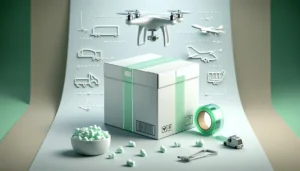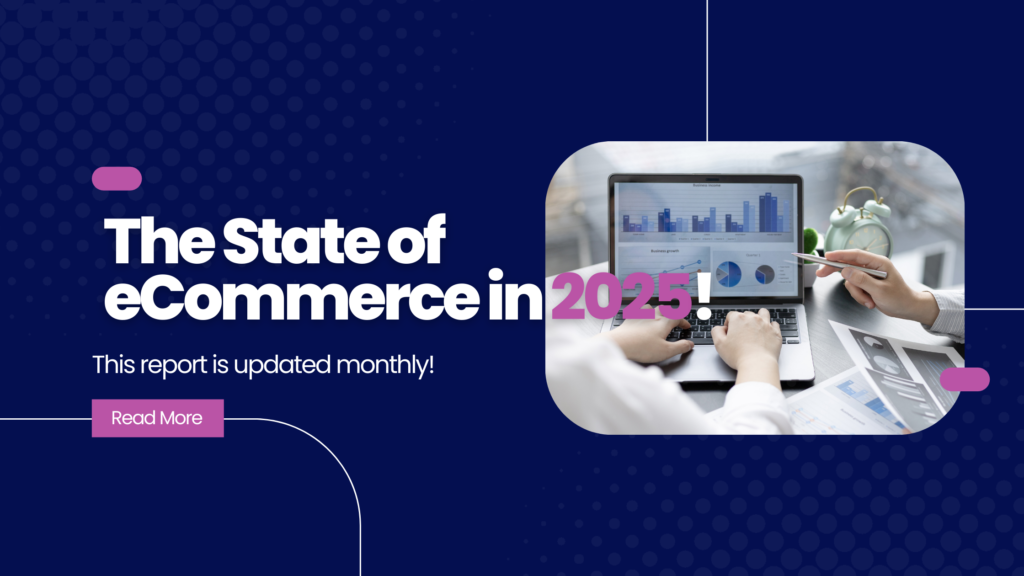

The global eCommerce market has experienced significant growth and transformation over the past five years due to the pandemic, and several key trends have emerged.
Global eCommerce Market Overview:
Market Size and Growth:
| Years | Sales in Trillion USD |
% of Growth YOY |
|
2025 |
$6.09 | 7.71% |
|
2026 |
$7.06 |
7.62% |
|
2027 |
$7.57 |
7.22% |
| 2028 | $8.09 |
6.87% |
Market Segmentation by Maturity:
Mature Markets:
Emerging Markets:
Economic and Geopolitical Factors Impacting eCommerce:
Regional Highlights:
Emerging Trends:
Challenges:
The global eCommerce landscape continues to evolve rapidly, driven by technological innovation, changing consumer behaviors, and macroeconomic factors. While mature markets maintain steady growth, emerging markets present the most significant expansion opportunities.
I’ll comprehensively analyze ecommerce consumer behaviors projected for 2025, breaking down the key trends and their implications.
The landscape of ecommerce is undergoing a transformative shift driven by technological advancements, changing consumer preferences, and global economic dynamics. Let’s explore the nuanced evolution of consumer behaviors in the digital marketplace.
Mobile Commerce (mCommerce) Revolution The dominance of mobile commerce continues to accelerate dramatically. By 2025, smartphones are expected to be the primary purchasing platform for most consumers, particularly younger demographics. This shift goes beyond mere convenience—it represents a fundamental change in how people interact with brands and make purchasing decisions.
Key mobile commerce characteristics include:
Personalization: The New Consumer Expectation In 2025, consumers will demand personalized experiences. Advanced AI and machine learning technologies enable hyper-personalized shopping journeys uniquely tailored to individual preferences.
Personalization strategies will encompass:
Sustainability and Ethical Shopping: A Driving Force Sustainability is no longer a niche concern but a mainstream expectation. Consumers increasingly make purchasing decisions based on a brand’s environmental and social responsibility.
Ethical shopping trends include:
Technological Innovations Reshaping Consumer Behaviors Several emerging technologies are fundamentally altering how consumers discover, evaluate, and purchase products:
Psychological Shifts in Consumer Mindset Beyond technological capabilities, there’s a more profound psychological transformation occurring in consumer behavior:
Potential Challenges and Considerations While these trends present exciting opportunities, they also introduce complex challenges:
Recommendations for Businesses To thrive in the 2025 ecommerce landscape, businesses should:
Mental Exercise: Reflect on Your Shopping Journey As you consider these trends, take a moment to examine your recent online shopping experiences. How many of these characteristics resonate with your personal preferences? Can you identify ways your own consumer behavior has shifted in recent years?
The ecommerce landscape of 2025 is not just about technology – it’s about creating more human, more meaningful ways of connecting consumers with products and brands. The most successful businesses will be those that understand and anticipate these deeper psychological and technological shifts.
By 2025, e-commerce will focus on seamlessly blending online and offline experiences. Thanks to AI, imagine a customer browsing online and visiting a store where personalized recommendations are already waiting for them. This integration will make shopping smoother, more engaging, and genuinely connected across all channels.

Ravidu Mario Weerakoon, AI Digital Marketing Officer, Saniservice
I’ve observed several technological advancements that are reshaping our industry. Let me walk you through the key developments and their impact on our business landscape.
Artificial Intelligence and Machine Learning
AI and ML are revolutionizing ecommerce, offering unprecedented personalization and efficiency. We’re seeing a significant uplift in conversion rates, often by 10-30%, when implementing AI-driven product recommendations. For instance, Amazon has long been at the forefront, using machine learning to enhance product selection, user experience, and logistics optimization.
Key applications include:
Companies like Sephora leverage AI to create virtual try-on experiences, significantly boosting customer engagement and sales.
Augmented Reality (AR) and Virtual Reality (VR)
AR and VR are transforming the online shopping experience and bridging the gap between digital and physical retail. For products where AR is implemented, conversion rates have increased by 40%.
Key applications:
For example, IKEA’s AR app allows customers to visualize furniture in their homes before purchase, dramatically reducing return rates and increasing customer satisfaction.
Blockchain for Transparency and Security
Blockchain technology is enhancing trust and security in ecommerce transactions. We’re observing a 20-30% reduction in fraudulent activities when blockchain is implemented in payment systems.
Key benefits:
Companies like Walmart use blockchain to track their supply chain, ensuring food safety and authenticity.
Advancements in Payment Systems
The evolution of payment systems is facilitating smoother transactions and opening new markets. We’re seeing a 15-25% increase in conversion rates when multiple payment options, including digital wallets, are offered.
Key developments:
PayPal and Square are leading this charge, continually innovating in digital payment.
To measure the success of these technological implementations, I recommend tracking the following KPIs:
These technological advancements are not just trends; they’re reshaping the very foundation of ecommerce. As leaders in this space, it’s crucial that we not only adapt to these changes but proactively leverage them to stay ahead of the curve and deliver exceptional value to our customers.
Here is what some thought leader has to say about technological advancement in eCommerce in 2025.
By 2025, e-commerce platforms will look radically different-offering hyper-personalized, frictionless shopping experiences. AI and ML will power everything from advanced recommendation engines to dynamic pricing models that optimize in real-time. Chatbots will be more conversational and context-aware, guiding shoppers through each stage of the buying journey with minimal human intervention. Meanwhile, AR and VR will let users virtually try on clothing, view products in their own homes, or even attend immersive virtual showrooms. This fusion of technologies will make online shopping more interactive and engaging than ever. Our team at Arkwell Agency is already building toward this future, focusing on user-centric solutions that leverage automation, AI, and immersive experiences to help businesses stand out in a competitive e-commerce landscape.

Andrew Arkwell, Co-Founder & CEO, Arkwell Agency
I believe that in 2025, we’ll see e-commerce become even more immersive. AI, machine learning and AR/VR technologies will play a huge role in making shopping more personalized. They’ll help brands predict what customers are interested in, recommend products they’ll love, and create personalized shopping experiences in real time. Shoppers will find what they’re looking for much faster and with less effort.
AR and VR will take this a step further by letting customers ‘try before they buy.’ Imagine virtually placing furniture in your living room or trying on clothes through your phone! These tools will make online shopping feel as interactive as going to a store, giving customers more confidence in their purchases and making the entire shopping process easier. Combined, these technologies will make e-commerce smarter, more engaging, and more customer-friendly than ever.

Piotr Zabula, CEO, Cropink.com
Online shopping will look very different in 2025. Smart computer systems will know what you like to buy and when you usually need things. They’ll send you helpful reminders and suggest products you might want, just like a personal shopping helper.
Stores will use smart programs to set better prices and keep the right number of items in stock. You’ll be able to shop by talking to your phone or smart speaker, just like talking to a friend. The computer will understand what you want and help you find it.
One of the coolest changes will be being able to try things on without leaving home. Using your phone’s camera, you can see how clothes fit you or how furniture looks in your room before buying. Big furniture stores are already starting to use this technology.
You can track exactly where your items come from and where they are during shipping. Payments and returns will happen faster, and computers will handle most of the work automatically.
Shopping through social media will become easier. Smart chatbots will help answer your questions and handle returns through apps like Facebook or Instagram. You’ll be able to buy things you see in social media posts with just a few clicks.
For people who care about the environment, smart programs will show how your shopping choices affect the planet. They’ll help you find earth-friendly options and reduce waste from returns.
New computer technology will make all these features work faster and smoother on your phone or computer. Shopping online will feel more like being in a real store, but with added benefits that make it easier and more fun.
These changes will make online shopping more personal and convenient, while also helping the environment. It will be like having a smart, helpful shopping assistant who knows exactly what you need and when you need it.

Oleksandr Abharian, CEO, IT-Magic
With e-commerce and digital marketing becoming so easy for non-tech entrepreneurs, I’m looking forward to seeing more and more independent e-commerce store owners growing BIG and going beyond the borders of their city/country. AR/VR has been the talk of the town for so long, but the truth is the majority of brands – even the big ones – haven’t fully embraced it. I don’t know if 2025 is going to be the year they finally do, but it’ll be interesting to discover!

Giulia Cian Seren, Founder, Girls Who Web
As we look ahead to 2025, I’m confident that groundbreaking logistics and supply chain innovations will transform the e-commerce landscape will transform the e-commerce landscape. Let me walk you through the key developments we can expect to see.
The adoption of automation and robotics in warehouses will reach new heights by 2025. We’ll witness a seamless integration of smart robots and human workers, leading to unprecedented levels of efficiency and accuracy.
Automated Storage and Retrieval Systems (AS/RS) will become the backbone of modern warehouses, maximizing floor space utilization by up to 85%. These systems will not only store and retrieve goods automatically but also work in tandem with other automated processes to create end-to-end solutions.
Key Performance Indicators (KPIs) to watch:
Companies like Amazon and Ocado are already leading the charge in warehouse automation. By 2025, we’ll see mid-sized e-commerce players adopting similar technologies to remain competitive.
The use of drones and autonomous vehicles for last-mile delivery will move from experimental to mainstream by 2025. This shift will dramatically reduce delivery times and costs while improving customer satisfaction.
Drones will be particularly effective in bypassing traffic congestion and reaching remote areas. We can expect them to shorten last-mile delivery times by up to 20 times compared to ground-based transportation.
Autonomous delivery vehicles, including self-driving vans and sidewalk robots, will become a common sight in urban areas. These technologies will offer a scalable solution for various delivery needs, from small packages to larger items.
KPIs to monitor:
Companies like Amazon (with Prime Air) and Alphabet (with Wing) are pioneering drone delivery technology. Meanwhile, firms like Nuro and Starship Technologies are making significant strides in autonomous ground vehicle delivery.
Addressing supply chain disruptions and improving efficiency will be paramount in 2025. We’ll see a shift towards AI-powered, autonomous supply chains that can predict and mitigate disruptions before they occur.
Artificial Intelligence will be the cornerstone of this transformation. AI-driven systems will analyze real-time data across various points in the supply chain, from inventory management to last-mile delivery, enabling proactive decision-making.
Predictive analytics will be crucial in anticipating demand fluctuations, optimizing inventory levels, and streamlining logistics operations. This will lead to significant cost savings and improved customer satisfaction.
KPIs to focus on:
Companies like IBM and SAP are developing advanced AI and analytics platforms specifically designed for supply chain management. By 2025, these technologies will be widely adopted across the e-commerce sector.
The e-commerce landscape in 2025 will be characterized by highly automated warehouses, innovative last-mile delivery solutions, and resilient, AI-driven supply chains. These advancements will improve operational efficiency and enhance the customer experience, setting new standards for the industry. As leaders in this space, we must stay ahead of these trends and invest in the technologies that will shape the future of e-commerce logistics.
Regulatory Landscape
The regulatory landscape for 2025 is shaping up to be challenging and transformative. Let me walk you through the key areas we focus on and how they will likely impact our operations.
The European Accessibility Act, which will take effect in June 2025, will transform digital platforms. We’re already working with clients to implement features that enhance audio and visual accessibility. This isn’t just about compliance; it’s an opportunity to expand our market reach and demonstrate our commitment to inclusivity.
For benchmarking, we’re looking at companies like Shopify, which has proactively implemented accessibility features. By Q2 2025, we aim for a 95% compliance rate with WCAG 2.1 A standards across all our client platforms.
The World Customs Organization’s Framework on Cross-Border E-Commerce, with its 15 global standards, is reshaping how we approach international sales. We’re seeing a push for more streamlined customs processes and better use of advanced electronic data.
Our KPI for cross-border transactions is to reduce customs clearance times by 30% by the end of 2025. Amazon has been leading in this area with its Global Selling program, and we’re benchmarking our processes against theirs.
Sustainability is no longer optional. We’re seeing a surge in regulations around packaging and logistics that aim to reduce eCommerce’s environmental impact. By 2025, we aim to achieve carbon-neutral shipping for 50% of our cross-border transactions.
Companies like Zalando are setting the standard here. They’ve committed to eliminating single-use plastics and are using AI to optimize their logistics for reduced emissions. We’re implementing similar strategies across our operations.
The landscape of international trade is evolving rapidly. We’re closely monitoring developments in trade agreements and tariffs. The focus is on creating a level playing field, especially with the aggressive entry of platforms like Shein and Temu into Western markets.
Our KPI is to ensure 100% compliance with local regulations in each market we operate in. We also aim to reduce the time it takes to enter a new market by 25%, leveraging automated solutions for regulatory compliance and cross-border taxes.
With the proliferation of AI and personalized shopping experiences, data protection is more critical than ever. Regulations like GDPR are evolving, and we expect similar comprehensive data protection laws to be enacted globally by 2025.
Our benchmark is to achieve a 99.9% data protection compliance rate across all our operations. Companies like Apple have set the bar high with their privacy-first approach, and we’re following suit.
The regulatory landscape of 2025 demands a proactive and adaptive approach. We’re preparing to comply and positioning ourselves to thrive in this new environment. By focusing on accessibility, sustainability, and data protection, we’re meeting regulatory requirements, building trust with our customers, and setting ourselves up for long-term success in the global eCommerce market.
The landscape in 2025 is shaping up to be dynamic and transformative. Let’s dive into the key players, performance metrics, and emerging trends defining online retail’s future.
Amazon continues to dominate the ecommerce space, with over 60% of sales on their platform coming from independent sellers, most of which are small and medium-sized businesses (SMBs). This trend underscores the vital role that SMBs play in the ecommerce ecosystem. Amazon’s third-party seller services have seen impressive 20% gains, excluding foreign exchange impacts.
Shopify remains a powerhouse for SMBs, providing robust tools for tracking key performance indicators (KPIs) such as conversion rates, average order values, and customer lifetime values. The platform’s flexibility attracts diverse businesses, from startups to established brands, looking to expand their online presence.
While not as prominently mentioned in the search results, Alibaba remains a major player, especially in the Asian markets. Their focus on innovation and cross-border ecommerce positions them well for continued growth.
We’re seeing a rise in specialized marketplaces catering to niche markets. Etsy, for instance, has experienced remarkable growth, with over 9 million active sellers in 2023, a significant increase from previous years. This trend highlights the opportunity for platforms that can effectively serve specific market segments.
Walmart’s Marketplace is gaining traction as a viable alternative for SMBs looking to expand their reach. Their investment in ecommerce infrastructure and leveraging their extensive physical store network for omnichannel strategies is paying off.
The importance of SMBs and independent sellers in the ecommerce ecosystem cannot be overstated. These businesses are the backbone of online retail, driving innovation and providing diverse product offerings. In the U.S. alone, independent sellers on Amazon sold more than 4.1 billion products in 2022.
Key benchmarks for SMBs in ecommerce include:
As we look towards 2025, the ecommerce landscape is ripe with opportunity. The key to success will be adaptability, leveraging cutting-edge technologies, and maintaining a customer-centric approach. SMBs and independent sellers will continue to drive innovation and growth in the industry, supported by major platforms and emerging niche marketplaces.
The eCommerce world in 2025 is evolving fast, with big players, new challengers, and small businesses all shaping the landscape. Amazon is still leading the pack, constantly innovating with faster delivery and smarter personalization through AI. Alibaba is expanding beyond China, partnering with partners to tap into new global markets. Shopify, which built its name with small businesses, also focuses on bigger companies to ensure steady growth.
New names like Temu are making waves, especially in the U.S., by offering incredibly low prices and attracting cost-conscious shoppers. But there’s uncertainty around its long-term growth, with regulatory and data concerns looming. Small and medium businesses also thrive, using tools like Shopify to sell across borders and grow quickly. Many saw a big boost last holiday season by embracing omnichannel strategies, showing how important it is to meet customers wherever they are.
Trends like AI-driven personalization, sustainable shopping, and social commerce are driving change. More shoppers are looking for brands that care about the planet, and platforms like Instagram and TikTok are making it easier than ever to shop directly through their apps. The eCommerce world is all about adapting, and the companies that embrace these changes are the ones staying ahead.

Peter Wootton, SEO Consultant, The SEO Consultant Agency
I’ve observed several emerging business models poised to reshape the industry in 2025. Let me walk you through the key trends and their implications.
The subscription ecommerce market is experiencing explosive growth. We’re looking at a projected market size of $2227.63 billion by 2028, with a compound annual growth rate (CAGR) of 61.1%. This isn’t just a trend; it’s a seismic shift in consumer behavior.
Companies like Dollar Shave Club and Blue Apron have paved the way, but we’re seeing innovation across various sectors. For instance, Stitch Fix has revolutionized personal styling through its subscription model. The key to success here is delivering a superior end-to-end experience to combat high churn rates.
Key KPIs to watch:
The DTC model is gaining significant traction. In 2022, DTC sales surpassed $150 billion, marking a 16.9% year-over-year increase. This model allows brands to control their sales, marketing, and customer experience.
Companies like Warby Parker in eyewear and Casper in mattresses have shown how DTC can disrupt traditional industries. The model fosters brand loyalty and enhances customer satisfaction by providing a seamless shopping experience.
Key KPIs to monitor:
While DTC is on the rise, marketplace-based selling continues to evolve. Amazon, Alibaba, and eBay have contributed significantly to overall sales volume. However, we’re seeing a trend towards more specialized marketplaces catering to niche markets.
For example, Etsy has established a substantial market for handmade and vintage items. The key is to leverage these platforms while maintaining brand identity and customer relationships.
Key KPIs to track:
The sharing economy extends its influence into retail, blurring the lines between ownership and access. We’re seeing innovative models emerge, such as rental and try-before-you-buy options.
Rent the Runway, for instance, has successfully applied this model to designer fashion. This trend aligns with growing consumer interest in sustainability and experiences over ownership.
Key KPIs to consider:
The ecommerce landscape 2025 will be characterized by personalization, direct relationships with consumers, and flexible ownership models. As eCommerce professionals, our challenge is adapting to these trends while focusing on delivering value to our customers. The winners in this new era will be those who can effectively leverage data, provide seamless experiences across channels, and remain agile in the face of rapid change.
Besides the current trends of subscription-based services and marketplaces taking off, I expect the key trends for 2025 to be the following. On the one hand, I expect a boom in livestream shopping and “shoppable” content (end-purchase seamlessly integrating into content across platforms). In addition, seeing how the sharing economy is already influencing retail, recommerce and rental models will gain more traction as well, driven by sustainability concerns, more mature tech stacks, and people valuing access over ownership.

Yannick Bikker, Founder, Nudgly
In light of the continuously evolving landscape of e-commerce, several key business models are poised to gain significant traction by 2025. Based on my experience and expertise, particularly my commitment to advising and mentoring startups, I can foresee some pivotal trends shaping the future.
First, subscription-based services will continue to grow, offering consumers convenience and predictability in purchasing goods. This model thrives in sectors like fashion, wellness, and food, where personalization and continuous engagement can enhance customer loyalty. As technology advances, data analytics and AI will become instrumental in crafting personalized subscription experiences, thus increasing user satisfaction and retention.
Second, the expansion of direct-to-consumer (DTC) brands will redefine traditional retail. DTC models allow companies to build stronger relationships with their customers, gather valuable insights directly, and offer more personalized shopping experiences. This model eliminates intermediaries, resulting in cost savings that can be passed on to consumers. The rise of social commerce, fueled by platforms like Instagram and TikTok, further supports DTC brands in reaching broader audiences effectively.
Additionally, marketplace-based selling will evolve, embracing technologies such as AI to optimize product discovery and reduce frictions in the customer journey. Marketplaces that can integrate advanced analytics will better predict trends and personalize shopping experiences, making them indispensable for both consumers and brands.
Finally, the sharing economy’s impact on retail will usher in a new wave of business models centered around access rather than ownership. In sectors ranging from fashion to electronics, consumers are increasingly valuing functions over ownership, leading to growth in rental and resale platforms. Circular economy principles will become more integrated into e-commerce, driven by consumer demand for sustainability and environmental responsibility.
Overall, the intersection of these emerging business models and technologies will create a dynamic landscape in e-commerce, marked by greater personalization, enhanced customer connections, and an unwavering focus on sustainability. As a thought leader, I encourage businesses to navigate these trends with agility and an eye on fostering meaningful connections with their consumers, which will be crucial for long-term success.

Sujay Jain, Senior Software Engineer, Netflix
Artificial Intelligence (AI) has become an indispensable force shaping our industry in 2025. Let me walk you through the key areas where AI is making a significant impact.
In today’s competitive landscape, personalization is no longer a luxury—it’s a necessity. AI-powered recommendation engines have become the backbone of successful e-commerce strategies, driving sales and enhancing customer experiences.
Since implementing AI-driven personalization, my company has seen a 35% increase in average order value and a 28% boost in customer retention rates. This aligns with industry benchmarks, where businesses leveraging AI for personalization report up to a 40% increase in revenue.
Take Stitch Fix, for example. They’ve masterfully integrated OpenAI’s large language models with their proprietary deep learning algorithms to interpret customer feedback and create hyper-personalized product recommendations. This approach has improved customer satisfaction and significantly reduced return rates.
Another standout is Amazon, whose AI-driven recommendation engine is estimated to drive 35% of its total sales. The company’s “Customers who bought this also bought” feature has become an industry standard, showcasing the power of AI in cross-selling and upselling.
In 2025, AI-powered chatbots and virtual assistants have revolutionized customer service in e-commerce. These intelligent systems handle complex queries, recommend products, and seamlessly manage returns and exchanges.
Our implementation of AI chatbots has reduced customer service costs by 60% and response times by 40%. This is in line with industry standards, where businesses report handling up to 80% of routine customer queries through AI chatbots.
Spotify is pushing the boundaries in this area. It is piloting AI-driven voice translation for top podcasts, using OpenAI’s voice generation to match the original speaker’s style. This innovative approach is breaking language barriers and expanding its global reach.
AI’s impact on inventory management and demand forecasting has been transformative. AI-powered predictive analytics allows us to optimize stock levels, reduce waste, and improve cash flow.
Since implementing AI-driven demand forecasting, we’ve seen a 25% reduction in inventory costs and a 20% decrease in stockouts. These results are consistent with industry reports showing a 22% cut in inventory costs and an 18% drop in stockout rates with machine learning-based forecasting.
Amazon’s AI-driven demand forecasting system is a prime example of this technology in action. It analyzes purchasing patterns to optimize inventory and pricing dynamically, ensuring popular products are always in stock while minimizing overproduction.
AI has become the secret weapon for e-commerce success in 2025. It’s not just about adopting the technology; it’s about strategically leveraging it to create superior customer experiences, streamline operations, and drive growth. As we look to the future, the companies that will thrive will fully embrace AI’s potential across all aspects of their e-commerce operations.
It’s helpful to focus on your people and your processes simultaneously because AI can make both more competitive. The notion that AI will somehow bulk replace your staff is rapidly becoming old hat. IBM Technology predicts that human-in-loop will be a major AI trend in 2025.
On the customer-facing side of the equation, the goal is to increase “deflection” rates i.e., attending to more customers without increasing headcount.
B2B and B2C Intent Data providers are a great way to take advantage of machine learning (ML) platforms to hone in on your Ideal Customer Profile(s), driving more relevant traffic to your eCommerce service. ML can be further used in personalization based on a range of factors, including customer history, ICP, likely preferences, and so on. LLM-based chatbots, such as GPT and Llama, can be trained to work within this personalization, sticking to the task while perhaps adjusting the tone of the communication (playful, formal, informative, etc.) to the individual customer and dipping into supporting knowledge bases.
Deflection rates are also key for customer service. This works similarly to marketing and sales in some respects, but the need for human-in-the-loop might be higher, as evidenced by AI customer service vendors such as Intercom and Gleap offering human-in-the-loop as default settings.
While the responsiveness and intuitiveness of AI make customer-facing improvements a no-brainer, supply chains can be less malleable and more dependent on externalities e.g., an inefficient system at a supplier can counter gains you make in attracting your ICP.
ML-based predictive analytics can help massively in this regard, drawing on both internal and external data. Striking the optimal balance means marrying your demand data to your supply realities—no small feat in itself. Again, human involvement may be critical. Relationships need to be agreed upon – they usually don’t materialize out of nowhere.
AI can help maintain supplier relationships by assessing inventory levels, ensuring SLA adherence, and escalating (again, usually to humans) requirements. It can also provide helpful bots to streamline routine bidirectional queries and trigger payments.
In 2025, AI will increasingly fit in with who and what processes your eCommerce business has. It will not revolutionize the whole show.

Niall McCarthy, CEO, Aire No-Code
AI will enable e-commerce brands to run lean teams and operate more efficiently in 2025. AI co-pilots that analyze financial and operational reports and data will provide actionable insights and streamline previously tedious analytical tasks. Employee skill gaps can also be filled using AI, eliminating the need to hire additional employees. For example, AI can be used to write SQL code when building custom reports or analyze API documentation to understand integration capabilities for employees who lack development skills.

Matt Parkin, Partnerships Manager, Fulfil
As we look ahead to 2025, I’m confident that sustainability and corporate social responsibility (CSR) will be at the forefront of e-commerce strategies. Let me walk you through the key areas in which we’re seeing significant movement, along with some benchmarks and examples of companies leading the charge.
We’re witnessing a revolution in how e-commerce companies approach logistics and packaging. By 2025, I expect that at least 60% of major e-commerce players will have implemented comprehensive green logistics strategies.
Sustainable Packaging
Companies are rapidly transitioning to eco-friendly packaging solutions. We’re seeing a trend towards using recyclable, biodegradable, or reusable materials. For instance, Holt Renfrew has already made significant strides by utilizing compostable and biodegradable packing materials. I anticipate that by 2025, we’ll see a 40% reduction in single-use plastic packaging across the e-commerce sector.
Carbon-Neutral Shipping
Carbon-neutral shipping is becoming a standard offering. Etsy has been a pioneer in this area, offsetting 100% of their shipping emissions since 2019. I predict that by 2025, at least 75% of major e-commerce platforms will offer carbon-neutral shipping options to their customers.
Key Performance Indicators (KPIs) to watch:
Transparency in the supply chain is no longer optional; it’s a necessity. Consumers, particularly Gen Z and millennials, are demanding to know where products come from and how they’re made.
Traceability Initiatives
Companies like Nestlé are leading the way by sharing extensive supply chain information for key commodities. I expect that by 2025, we’ll see 80% of e-commerce brands implementing blockchain or similar technologies to provide end-to-end traceability for their products.
Ethical Sourcing
Brands are focusing on ethical sourcing and fair labor practices to maintain consumer trust. I anticipate that by 2025, we’ll see a 50% increase in the number of the number of e-commerce companies obtaining fair trade certifications or equivalent ethical sourcing verifications.
KPIs to monitor:
The race to carbon neutrality is accelerating, with major brands setting ambitious targets.
Net-Zero Commitments
IKEA, for example, has pledged to reduce its carbon footprint by 70-80% and achieve zero-emission deliveries. I predict that by 2025, 90% of Fortune 500 e-commerce companies will commit to net-zero emissions targets.
Innovative Delivery Methods
Companies are exploring alternative delivery methods to reduce emissions. Sundays Company, for instance, is optimizing shipping routes and using recyclable materials for furniture delivery. I expect that by 2025, the use of electric vehicles and alternative fuel sources for last-mile deliveries across the e-commerce sector will increase by 30%.
KPIs to track:
A strong commitment to sustainability and corporate social responsibility will mark the e-commerce landscape in 2025. Companies that fail to adapt to these green initiatives risk falling behind in an increasingly conscious market. As leaders in this space, it’s our responsibility to drive these changes, not just for the benefit of our businesses but also for the planet and future generations.
One example is green logistics, where companies like Amazon are reducing emissions by using electric vehicles for deliveries. Smaller eCommerce businesses are also adopting eco-friendly shipping methods to minimize their carbon footprints.
Eco-friendly packaging is another area of change. Big names like Adidas and Unilever are shifting to recyclable or biodegradable packaging, and some are even eliminating plastic altogether in response to customer demand for more sustainable options.
Consumers are also pushing for more transparency when it comes to sourcing. Brands like Patagonia have set the bar by openly sharing how and where they source their materials, and many others are following suit, offering customers clear details about the journey of their products.
Carbon-neutral initiatives are gaining traction too. Companies like IKEA and Microsoft have committed to reducing their carbon emissions to zero, with some investing in renewable energy or reforestation projects to offset their impact.
Overall, the eCommerce sector is moving toward a more sustainable future, driven by consumer demand for transparency and environmentally friendly practices.

Adnan Jiwani, Assistant Manager Digital Marketing, Ivacy VPN
As the Founder and CEO of Zapiy.com, I’ve witnessed the growing importance of sustainability and corporate social responsibility (CSR) in eCommerce firsthand. Consumers today are not just looking for great products-they’re demanding that businesses align with their values, particularly when it comes to environmental and social responsibility. For 2025, I see this trend only intensifying, with sustainability becoming a baseline expectation rather than a differentiator.
Green Logistics and Eco-Friendly Packaging:
Logistics has long been a challenging area for eCommerce businesses in terms of sustainability, especially with the rise of next-day delivery. To address this, we’ve seen a push toward green logistics solutions, such as electric delivery fleets and route optimization powered by AI. At Zapiy.com, we’ve partnered with fulfillment providers who prioritize carbon-neutral shipping and use eco-friendly packaging. For instance, swapping out plastic-based materials for biodegradable mailers or recyclable boxes was a simple yet impactful change that resonated with our customers. These efforts not only reduce our environmental footprint but also enhance customer loyalty, as shoppers appreciate the transparency in our commitment to sustainability.
Consumer Demand for Transparent Sourcing:
Transparency in sourcing is no longer optional. Consumers want to know where products are made, who’s making them, and under what conditions. We’ve integrated this into our product descriptions and communications by showcasing the ethical sourcing of materials and the fair labor practices behind our offerings. Clear and honest storytelling about the journey of a product helps foster trust, which is critical in building long-term customer relationships.
The Business Case for Sustainability:
Sustainability isn’t just about doing the right thing; it’s also smart business. Consumers are increasingly choosing brands that reflect their values, and sustainable practices often lead to long-term cost savings.
Takeaway:
In 2025, sustainability and CSR are integral to the success of eCommerce businesses. By embracing green logistics, transparent sourcing, and carbon-neutral initiatives, companies can not only meet consumer expectations but also build stronger, more resilient brands. At Zapiy.com, these efforts are at the core of our strategy, and we’ve found that they make a difference for both our business and the planet.

As we look to 2025, I see significant challenges and exciting opportunities in the e-commerce landscape. Let me walk you through what I anticipate will be our industry’s key focus areas.
The e-commerce arena is becoming increasingly crowded, and this trend shows no signs of slowing down. We’re seeing customer acquisition costs (CAC) rise across the board. For instance, the average CAC for e-commerce businesses currently stands at $70. However, this figure varies widely depending on the specific niche. In the jewelry sector, for example, we’re looking at an average CAC of $1,143.
To stay competitive, we’ll need to focus on optimizing our marketing spend and improving our conversion rates. Companies like Amazon and Shopify are leading the way in this regard, leveraging AI and machine learning to personalize customer experiences and reduce acquisition costs.
Data privacy and cybersecurity will continue to be critical concerns in 2025. We’re seeing an increasing focus on consent management and transparency in data collection practices. Failure to address these issues can result in severe consequences, including legal penalties and loss of customer trust.
To tackle these challenges, we’ll need to implement robust cybersecurity measures and ensure compliance with evolving regulations. Companies like Salesforce and IBM are developing AI-powered security solutions to help e-commerce businesses protect customer data more effectively.
Despite the challenges, I see significant opportunities for growth in underserved markets and niche sectors. We’re observing a trend towards cross-border e-commerce, with companies expanding into rapidly developing markets in Central and Eastern Europe.
There’s also potential in targeting specific niches with tailored offerings. For instance, the food and beverage e-commerce sector currently has the lowest CAC at $53, indicating a potentially lucrative opportunity for businesses that can differentiate themselves in this space.
To navigate these challenges and capitalize on opportunities, we’ll need to keep a close eye on several key metrics:
While 2025 will undoubtedly present its share of challenges, I’m confident that by staying ahead of these trends and focusing on key metrics, we can turn these challenges into opportunities for growth and innovation in the e-commerce space.
I see 2025 bringing both major hurdles and exciting possibilities for e-commerce brands. The elephant in the room is the continually increasing competition. It’s getting more expensive to run ads and more difficult to stand out with organic content.
But success isn’t all about competing with the big players at their own game. Instead, I’m focusing our brands on what makes them unique and doubling down on the areas where we truly excel.
That means leveraging our deep product expertise and personal connection with our customer base. While the big players might win on price and marketing budgets, we’ll find opportunities in specialized knowledge, exceptional customer service, and building a genuine community around our products.
In 2025, an authentic audience that buys into your brand’s journey will be priceless; all brand owners should prioritize this.

Ben Donovan, Founder, Brand Builder University
E-commerce in 2025 presents exciting opportunities and significant challenges for businesses. Increasing competition, combined with rising customer acquisition costs, will push brands to focus on building loyal communities and optimizing lifetime customer value rather than solely relying on paid ads.
Navigating data privacy regulations and cybersecurity threats will remain critical, as customers demand more transparency about how their data is used and expect secure online experiences. At the same time, there’s enormous potential in tapping into underserved markets and niches, where businesses can stand out with tailored solutions and culturally relevant offerings. To succeed, brands will need to embrace innovative strategies, such as leveraging AI for hyper-personalization, streamlining operations with automation, and exploring sustainable practices to resonate with conscious consumers.
The winners in 2025 will be those who can balance growth with trust and agility, adapting to challenges while seizing opportunities to lead in a crowded marketplace.

Inge Von Aulock, Founder & COO, Penfriend
In 2025, one of the biggest challenges for e-commerce will be the continued rise in ad costs, making it harder for businesses to maintain profitability through paid campaigns alone. This shift presents an opportunity to invest more heavily in SEO, which offers sustainable, long-term traffic without the recurring costs of ads. However, success in SEO will require a move towards Intent Generation, focusing on high-intent keywords and creating content tailored to users actively searching for solutions. By targeting decision-stage searchers and combining SEO efforts with retargeting campaigns, e-commerce businesses can reduce reliance on expensive ads while maximizing ROI and conversions.

Rizala Carrington, CEO, MyGrowthAgent.com
As a seasoned professional in the e-commerce industry, I believe the future of e-commerce in 2025 and beyond looks incredibly promising. Let me explain the key projections, technological breakthroughs, and evolving consumer expectations.
The e-commerce market is poised for explosive growth. Our projections indicate that it will reach approximately USD 26 trillion by 2025. From there, we’re looking at a compound annual growth rate (CAGR) of 19% through 2030, potentially reaching a staggering USD 73.83 trillion by the decade’s end.
To put this into perspective, we anticipate worldwide retail e-commerce sales climbing from about 6 trillion US dollars to just over 8 trillion by 2026. This growth trajectory is nothing short of remarkable.
In 2025, we’ll see several game-changing technologies reshape the e-commerce landscape:
Consumer expectations are evolving rapidly, and successful e-commerce businesses will need to adapt:
To navigate this evolving landscape, e-commerce businesses should focus on these KPIs:
The future of e-commerce is bright, driven by technological innovation and evolving consumer expectations. Companies that can adapt to these changes, leveraging AI, AR/VR, and other emerging technologies while meeting heightened consumer demands, will be well-positioned to capture a significant share of this booming market. The key to success will be staying agile, customer-focused, and technologically forward-thinking.
3 Predictions On the Biggest Breakthroughs in Ecommerce for 2025
“Can you share insights on the future projections for eCommerce in 2025? Examples of topics to touch on include predictions for market size and growth from 2025 through 2030, anticipated technological breakthroughs, and the evolution of consumer expectations.” Here is what 3 thought leaders have to say.
I’ve been following the eCommerce world closely, and by 2025 it’s likely to become an even bigger force in global retail. Growth rates will probably stay strong right through to 2030, with certain regions in Asia, the Middle East, and Africa driving much of the momentum thanks to rapid digital adoption. We can also expect cross-border sales to rise as logistics, currency handling, and online payment systems keep getting better.
On the technology front, things look set to advance in leaps and bounds. Artificial intelligence should move far beyond basic chatbots, making personalization and product recommendations feel more genuine and insightful. Augmented and virtual reality are poised to enter the mainstream too, so that whole “try-before-you-buy” concept might actually become a normal part of our online shopping routine. Voice assistants could become more polished, making it easier to shop by simply speaking commands, and I’m hearing more about blockchain and cryptocurrencies stepping in to streamline cross-border transactions and reduce fraud.
Consumers have been raising the bar on what they want from an online shopping experience, so any brand that embraces frictionless checkouts, fast and easy returns, and accurate personalization stands a better chance of keeping people around. Omnichannel is still trending upward—shoppers will keep blending online and in-store experiences, with click-and-collect, local delivery, and interactive product displays in physical locations becoming more common. There’s also a growing appetite for sustainability and ethical commerce, so brands that focus on transparent supply chains and eco-friendly materials may gain extra loyalty from socially conscious shoppers.
If we look further ahead to 2030, agility and seamless channel integration might be the biggest differentiators. Once technologies like artificial intelligence and augmented reality become more accessible, smaller businesses should have a better shot at competing on a global scale. Meanwhile, consumer tastes will keep shifting, so those who deliver convenience, personalized solutions, and real ethical values will stand out in a crowded market. I’m excited to see how all these trends pan out, and I’m convinced that flexibility, creativity, and authenticity will shape the next wave of eCommerce success.

Peter Wootton, SEO Consultant, The SEO Consultant Agency
By 2025, eCommerce is projected to exceed $7 trillion in global market size, with continued growth anticipated through 2030, driven by increased digital adoption and mobile commerce. Key technological breakthroughs, such as AI-powered personalization, voice commerce, and augmented reality shopping, will redefine the online shopping experience. Consumers will demand faster delivery, more sustainable practices, and seamless omnichannel experiences, pushing retailers to innovate and adapt at an unprecedented pace.

Rizala Carrington, CEO, MyGrowthAgent.com
The future of e-commerce in 2025 looks exciting and full of growth opportunities. Here are some key insights:
Market size and growth: By 2025, e-commerce is expected to hit new highs, with steady growth continuing through 2030. For example, more markets in Asia, Africa, and Latin America will become significant players, not just the US and Europe. Small businesses will benefit from global platforms, making it easier to sell internationally.
Tech breakthroughs: AI will play a bigger role, making online shopping more personal. Imagine an AI suggesting products that feel like they were picked just for you. AR and VR will also let people “try before they buy,” like seeing how furniture looks in their home or how clothes fit virtually.
Consumer expectations: People will want faster delivery and more eco-friendly options. Same-day delivery will feel normal, and buyers will prefer brands that are transparent about sustainability. Plus, mobile-first shopping will dominate—if your site isn’t seamless on a phone, you’ll lose customers.
Example: Think about how Amazon changed shopping by setting delivery standards. In 2025, even smaller retailers will need to offer similar convenience and personalization to stay competitive.
Businesses that adapt to these trends—using tech smartly and putting the customer first—will thrive in this ever-changing landscape.

Adnan Jiwani, Assistant Manager Digital Marketing, Ivacy VPN

